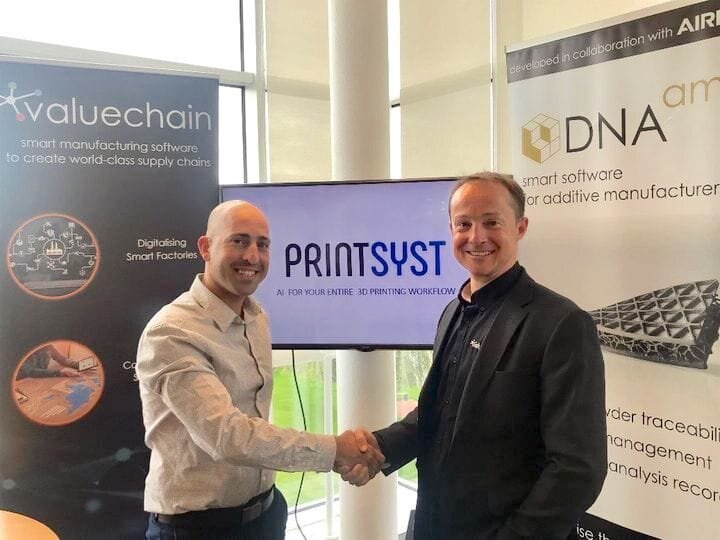![Printsyst CEO Itamar Yona and DNA.am Chairman Tom Dawes [Source: Printsyst]](https://fabbaloo.com/wp-content/uploads/2020/05/image-asset_img_5eb08c9e2da7e.jpg)
Printsyst lands significant investment to continue developing their AI-powered additive manufacturing solution.
The Israeli company has been working on a highly advanced system that can, in theory, automatically determine the optimum 3D print job parameters by merely examining the geometry of a part. It’s done through a machine learning approach that leverages a large database of historical 3D print jobs and their results.
Printsyst Partnership
Printsyst has partnered with a UK company, DNA.am, and this joint effort has been funded to the tune of £600,000 (US$788,000). What are they doing together?
It seems they are developing a comprehensive additive manufacturing process for production use in the aerospace industry. DNA.me provides a number of important services, which they call the “Building Blocks of Digital Additive Manufacturing Production”:
-
Standardise best practice AM build management
-
Streamline control of post-processing subcontractors
-
Ensure compliance with dynamic traceability
-
Capture AM intelligence
Those are all indeed necessary functions when attempting to perform production additive manufacturing. The actual printing portion of the work, while the central element, is actually a small portion of the effort required to properly manufacture objects.
Meanwhile, Printsyst provides these capabilities:
-
CAD Design
-
Object Detection
-
Automatic Repair
-
Slice for Print
-
Troubleshooting
Printsyst and DNA.me
As you can see, the two companies offer rather different services, but each complements the other. It seems to me that the combination of the two could be a powerful option for additive manufacturers to consider. One could say this is essentially an ERP (Enterprise Resource Planning system) for additive manufacturing.
There are additional benefits to Printsyst in this arrangement, as they have implanted their predictive AI solution within DNA.me’s process. The interesting part is that DNA.me already has many large clients who are performing additive manufacturing, forming a rather large and entirely new (to Printsyst) database to explore.
Printsyst’s machine learning system can then leverage all this new data to more easily predict successful 3D print job parameters because it can now learn from very large aerospace clients. This improves the algorithm’s results and makes it even easier for future improvements to be developed.
Is a machine learning-generated set of print parameters the best way forward? I think there’s a tradeoff here.
Manual Vs Automated 3D Print Parameters
Many current metal 3D print workshops employ a staff of engineers to carefully plot each print job in advance to ensure success, not only of the print job itself, but to ensure the parts produced are within tolerances.
That is a successful approach, but it is significantly expensive to maintain a squad of pricey engineers. A portion of their cost would have to be added to each and every successful print. This is one of the reasons why the typical price for parts produced with additive manufacturing technologies are very high.
On the other hand, if print parameters can be generated automatically as done by Printsyst, then the requirement for expensive engineers could theoretically drop. This would suggest parts produced using that technique could be priced less than those made using traditional manual tuning processes.
There is a question of the success ratio. Whatever the method of generating a print job’s parameters, there is still the possibility of a failure. The question is how the failure ratio differs between manual and automatically generated print parameters.
Initially, it’s conceivable that engineers might know more than an algorithm, but I suspect that over time the algorithm would catch up and eventually surpass the success ratio of the humans. And as that success ratio increases, the cost of prints will continue shrink, as there would be fewer failure costs to defray over the successful prints.
This could mean the future lies with automated solutions, not manual approaches.
Via Printsyst

